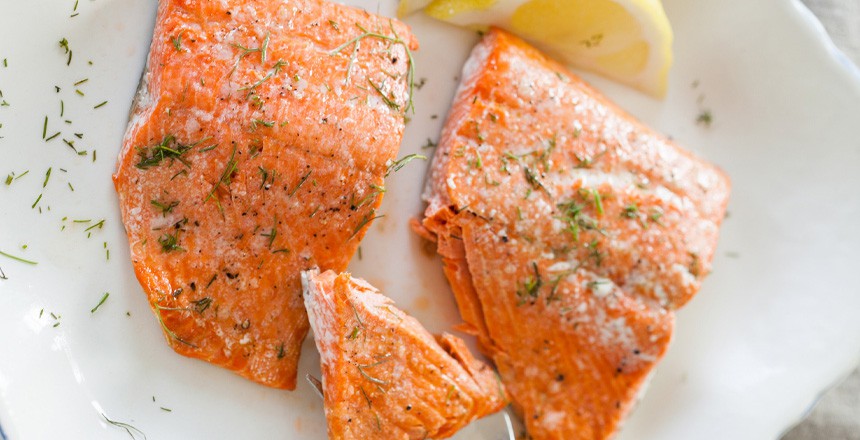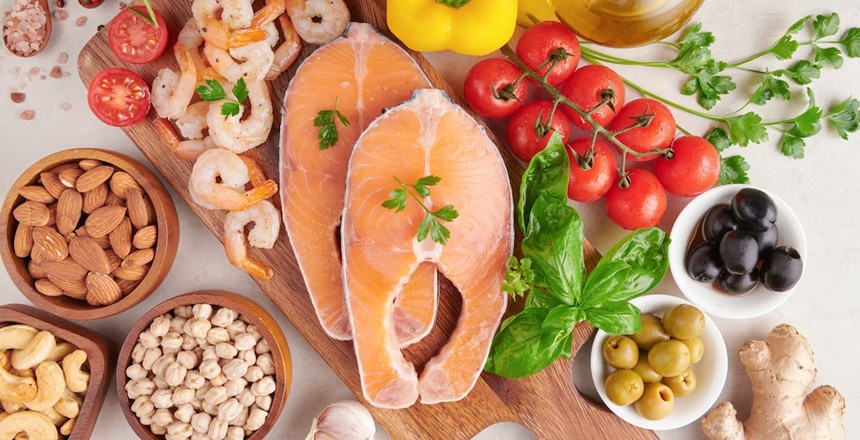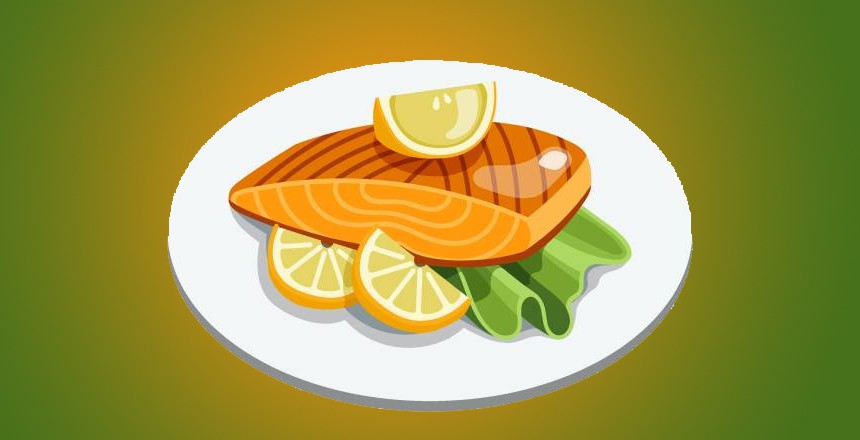Do you want to learn how to cook a delicious, oven-baked salmon in minutes? No need to be intimidated by the thought of cooking seafood – this quick & easy salmon recipe is perfect for even beginner cooks!
From prepping your tools and ingredients to plating up your finished meal, we guide you through each step. Once you get the hang of it, this simple dish can easily become an everyday favorite. Keep reading to find out more about roasting salmon in the oven!
Read also:
- How Long Does Salmon Last In The Fridge
- Is Smoked Salmon Cooked Or Raw
- How Long To Bake Salmon At 350 F
- How Long To Bake Salmon At 400°F
- How Long To Bake Salmon At 425
- How Long to Cook Salmon Patties
- How To Cook Costco’s Salmon Burgers
The Ideal Temperature To Cook Salmon

Salmon is a delicious and healthy protein choice that can be prepared in a variety of ways. To achieve the ideal texture and flavor, it is important to bake salmon at the right temperature. For the best results, bake salmon at 425°F for 12-15 minutes.
Otherwise, cooking salmon at a high temperature allows the skin to become crispy and the natural oils to caramelize, enhancing the overall flavor. With the mentioned temperature, you can confidently prepare a delicious and nutritious salmon dish for your next meal.
How To Select The Best Ingredients

The quality of your salmon dish is highly dependent on the freshness and quality of the ingredients you use. Take a close look at these factors:
- Choose wild-caught over farm-raised salmon as it tends to be healthier and more flavorful. Look for salmon that is firm to the touch and has a bright, vibrant color.
- Avoid any fish that appears bruised, discolored or has an off smell. Consider the cut of the salmon you’re purchasing – filets, steaks or whole fish are all popular options.
- Most importantly, check the labeling to ensure that the salmon has been sustainably sourced.
How To Have A Perfect Baked-Salmon
The appetizing dish must come from fresh and well-picked ingredients. This list of ingredients will ensure your salmon is cooked to perfection with a delicious, herbaceous flavor:
- Fresh salmon filets: first and foremost, make sure your salmon is fresh and high-quality for the best result.
- Olive oil or another high-heat oil: use a cooking oil with a high smoke point to prevent burning.
- Salt and pepper: season the salmon liberally with salt and pepper.
- Lemon slices or lemon juice for flavor: add a squeeze of lemon juice or thinly sliced slices to top it off.
- Garlic cloves or garlic powder: if you’re using fresh garlic, mince it and sprinkle it over the salmon.
- Fresh herbs such as dill, parsley, or thyme: to add brightness to the dish
Now that you’ve chosen your salmon and the ingredients, it’s time to prepare the meal:
- Preheat your oven to 425°F and line a baking sheet with parchment paper.
- Pat your salmon dry with a paper towel before brushing it lightly with olive oil or butter on both sides.
- Season generously with salt, pepper, garlic powder and other herbs/spices you prefer.
- Place your salmon onto the parchment paper and arrange lemon slices on top.
- Bake for 12-15 minutes or until the internal temperature reaches 140°F in the thickest part of the fish.
- Once done, remove from the oven and let cool for 5 minutes before serving.
We hope that this guide has shown you how to cook salmon in the oven with ease. Follow these instructions and you’ll be able to have a perfect baked-salmon every time!
Common Mistakes To Avoid While Cooking Salmon
When it comes to baking salmon, there are a few mistakes that you should avoid:
- Not Preheating The Oven – To have a perfectly cooked salmon, make sure you preheat the oven before baking so that the desired temperature is achieved.
- Overcooking The Salmon – The fish should be cooked for 12-15 minutes at 425°F or until the internal temperature reaches 140°F in the thickest part of the fish. Any more than that will cause your salmon to become dry and flavorless.
- Not Testing For Doneness With A Thermometer – Using a thermometer is key to ensure doneness and avoid over/undercooking the salmon.
- Adding Too Much Salt – Over seasoning your salmon can lead to an overly salty
dish. Add a pinch of salt at a time and taste as you go to find the balance that you like.
Finally, be sure to properly prepare the cooking surface by preheating the pan or grill and using plenty of oil to prevent sticking. By avoiding these mistakes, you’ll be able to cook a perfect piece of salmon every time.
Store The Baked Salmon
If you’re wondering how to store your baked salmon, the key is to prevent the fish from drying out while in the refrigerator or freezer. Here are a few tips to keep your salmon fresh and flavorful:
- Store baked salmon in an airtight container or wrap tightly with plastic wrap to prevent air from getting in.
- Put the container in the coldest part of the fridge or freezer, usually in the back or on a bottom shelf.
- For best results, eat refrigerated baked salmon within 3-4 days and frozen baked salmon within 2-3 months.
Following these simple steps, you’ll be able to enjoy your baked salmon for longer periods of time without sacrificing taste or texture.
Side Dishes To Go With Cooked Salmon
Salmon is a versatile and flavorful fish that pairs well with many other ingredients.
- Roasted vegetables such as brussels sprouts, carrots, or asparagus make for a colorful and healthy addition to any salmon dinner.
- A light and refreshing cucumber salad with dill and lemon complements the rich flavors of the fish.
- A quinoa or couscous salad with chopped almonds and dried cranberries adds some crunch and texture to the meal.
- For something more indulgent, creamy mashed potatoes or garlic bread can be a delicious pairing.
No matter what side dishes you choose, be sure to keep the flavors and textures balanced with the salmon to create a well-rounded and satisfying meal.
FAQs
Why Do Many People Bake Salmon At 350 Or 400?
These temperatures are the ideal temperatures for baking salmon, as they can help to ensure that the salmon is cooked evenly and quickly. This ensures that the fish will be flaky and moist, not dry or rubbery.
Read more about cooking salmon at 350F and 400F.
What To Season My Salmon With?
When seasoning your salmon, you want to choose flavors that will compliment the fish’s natural taste. A few of our favorites are lemon juice, garlic, dill, and oregano. As for the type of oil to use when cooking, olive oil is always a great choice.
Do You Put Oil Or Seasoning First For Salmon?
You can put either one first, depending on your preference. If you are using oil to cook with, it is usually best to put that on the salmon before adding any seasoning. This allows for better absorption of the seasonings and flavor into the fish.
What Brings Out The Flavor Of Salmon?
The best way to bring out the flavor of salmon is to use fresh ingredients. A squeeze of lemon juice, a sprinkle of salt and pepper, and some fresh herbs make a delicious marinade for salmon. Other things like garlic, ginger, and soy sauce can also add great flavor to your fish.
How Do I Know When Salmon Is Done?
The best way to know when salmon is done is to use a thermometer. Baked salmon should reach an internal temperature of 145F, while other cooking methods may require slightly different temperatures.
What Is The White Stuff That Comes Out Of Salmon?
The white stuff that comes out of salmon is called albumin. It is a protein released during the cooking process and should not be a cause for alarm. It can actually help to keep the fish moist and tender, so if you are comfortable with it, you can leave it in the fish.
Should I Cook Salmon With Butter Or Oil?
Both butter and oil can be used to cook salmon. When using butter, it is important to ensure that it does not burn, so it should be heated to a low temperature. Oil is typically preferred for salmon as it can help to keep the fish moist and tender without burning.
Do You Season Both Sides Of Salmon?
Yes, when seasoning your salmon it is important to season both sides. This will ensure that the flavor is evenly distributed throughout the fish.
Conclusion
Briefly, cooking salmon doesn’t have to be complicated or intimidating. This quick and easy oven-baked salmon recipe eliminates the fuss, and you’ll be delightfully surprised at just how delicious home-cooked salmon can be.
With How To Cook Salmon In The Oven | Quick & Easy Recipe – we hope you found this post helpful and that you enjoyed learning how to cook salmon quickly and easily. You’ll impress everyone with your newfound magical cooking skills; it’s easier than it seems!


